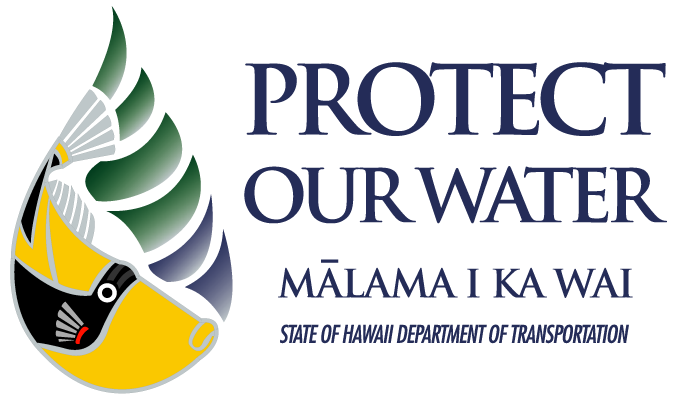Storm water is everybody’s business!
Construction is a major industry in our islands. However, while great for the economy, construction can have potentially disastrous effects on the environment. Construction activities can increase the rate of erosion by as much 1,000 times the natural rate. Sediment, the most common pollutant from construction activities, has been proven to cause monetary damages up to $16 billion per year.
Fortunately, HDOT Highways has a comprehensive construction site runoff control program to prevent water pollution during construction activities on State highways. Visit the tabs below for helpful information for design consultants and construction contractors working on HDOT Highways projects or with HDOT Highways right-of-way.
Designers
The plan to keep our water clean starts with design. Designers should consider both construction BMPs and permanent post-construction BMPs to minimize the environmental impact of the project. For files to assist in the development of site-specific construction BMP plans, please see below.
- Developing Your Stormwater Pollution Prevention Plan
- Storm Water Pollution Prevention Plan
- Application and Permit to Connect to the State of Hawaii Highways Storm Drain System
- Application and Permit to Discharge to the State of Hawaii Highways Storm Drain System
2022 Post-Construction (Permanent) Best Management Practices Materials (for projects initiated on or after July 1, 2022)
- 2022 Storm Water Post Construction Best Management Practices Manual
- 2022 Post-Construction (Permanent) BMP Review Checklist for MS4 Areas
- 2022 Post-Construction (Permanent) BMP Review Checklist for Non-MS4 Areas
- 2022 Post-Construction (Permanent) BMP Alternative Compliance Guide and Worksheet
2015 Permanent Best Management Practices Materials (for projects initiated prior to July 1, 2022)

Contractors
Contractors play a critical role in mitigating the pollutants generated from active constructed sites.
If you currently work for HDOT, or are thinking about doing work in HDOT rights-of-way, here are FAQs to consider before starting work on construction projects.
Do I need any permits for my project?
Am I working within HDOT right-of-way?
PERMIT NEEDED: State of Hawaii Department of Transportation
Permit to Perform Work Upon State Highways
Will my project discharge into an HDOT storm drain?
PERMIT NEEDED: State of Hawaii Department of Transportation
Application and Permit To Discharge to the State of Hawaii Highways Division Storm Drain System
Will my project connect to an HDOT storm drain?
PERMIT NEEDED: State of Hawaii Department of Transportation
Application and Permit For A Private Drain Connections To The State of Hawaii Highways Division Storm Drain System
To request HDOT permits, please contact HDOT via email at DOT.HWYO.Permits@hawaii.gov.
Does my project disturb an acre or more of land?
PERMIT NEEDED: National Pollutant Discharge Elimination System General Permit Coverage or Individual Permit Coverage
For more information about General Permit or Individual Permit coverage, please visit the State of Hawaii Department of Health website.
Do I need a Site-Specific Construction BMP Plan?
If you answer “YES” to any of the following questions, you need a Site-Specific Construction BMP Plan:
- Am I working on a project requesting a State of Hawaii Department of Transportation Application and Permit To Discharge to the State of Hawaii Highways Division Storm Drain System?
- Am I working on a project requesting a State of Hawaii Department of Transportation Application and Permit For A Private Drain Connections To The State of Hawaii Highways Division Storm Drain System?
- Am I working on a project requesting a State of Hawaii Department of Transportation Permit to Perform Work Upon State Highways?
For more information, please contact us. For permits and for files to assist in the review and implementation of BMPs, please see below.
- Construction Best Management Practices Field Manual (Oct 2021)
- Contractor BMP Plan Application (Rev. 2022)
- Storm Water Pollution Prevention Plan (SWPPP) Review Checklist for HDOT Contract Projects
- Application and Permit to Connect the State of Hawaii Highways Storm Drain System
- Application and Permit to Discharge to the State of Hawaii Highways Storm Drain System
- Enforcement Response Plan
- Permit Holder’s Guide Rack Card
2022 Post-Construction BMP Workshop
To learn more about our Permanent BMP criteria, download the presentation from our 2022 Post-Construction BMP Workshop.
2022 Post-Construction (Permanent) Best Management Practices Materials (for projects initiated on or after July 1, 2022)
- 2022 Storm Water Post-Construction (Permanent) Best Management Practices Manual
- 2022 Post Construction (Permanent) BMP Review Checklist for MS4 Areas
- 2022 Post Construction (Permanent) BMP Review Checklist for Non-MS4 Areas
- 2022 Post-Construction (Permanent) BMP Alternative Compliance Guide and Worksheet
2015 Permanent Best Management Practices Materials (for projects initiated prior to July 1, 2022)
2022 Protect Our Water Conference
Mahalo to everyone who attended the 2022 Protect Our Water Conference. Below you’ll find the presentation materials available for download:
- USACE Honolulu District Regulatory Program (Presenter: Michael Maaninen, United States Army Corps of Engineers, Regulatory Division, Honolulu)
- Updates to Appendices F & G - Hydrotesting and Dewatering Discharges to State Waters (Presenters: Jamie Tanimoto & Randee Tubal - Department of Health, Clean Water Branch)
- Harbors Updated Construction and Post-Construction Programs (Presenter: Ying "Joy" Zhang, P.E. - State of Hawaii, Department of Transportation, Harbors Division, Oahu District)
- DOH Enforcement Trends for Construction Storm Water and Upcoming Changes to E-Signature Requirements (Presenters: Jamie Tanimoto & Randee Tubal - Department of Health, Clean Water Branch)
- DOT - Airport's Construction Inspection BMP Program and the Veoci Construction Module (Presenters: Mikki Slentz, P.E. & Jenna Stone, CISEC - Haley & Aldrich)
- The World is PAVED with Good Intentions - But Sometimes You Hit a Pothole (Presenter: Claudia Akroyd, CHST, CISEC - Bowers + Kubota)
- Don't Muddy the Waters: Construction BMPs for Bridge Rehabilitation (Presenters: Fiona van Ammers, P.E., CPSWQ & Andrea Chung, P.E. - Brown & Caldwell)
Presentations from the 2022 Protect Our Water Conference can be found on our YouTube page.
2019 Protect Our Water Conference
Mahalo to everyone who attended the 2019 Protect Our Water Conference. Below you’ll find the presentation materials available for download:
- Keynote (Presenter: John McCullah, CPESC, Geomorphologist)
- Guarding the Future – Protecting Post Construction BMPs During Construction (Presenter: Jon Lowry, P.E. – EnviroServices & Training Center, LLC))
- Dirt Cheap: The Cost of Erosion (Why Be Compliant?) (Presenter: Eddie Snell – Applied Polymer Systems, Inc.)
- Lessons Learned: Internal Audit of DOT’s Construction Program (Presenter: Vijaya Tummala, P.E. – EnviroServices & Training Center, LLC)
- HIGHWAYS – Have You Ever Seen the Rain: Intro/Overview of Storm Water Requirements for Construction (Presenter: Larissa Sato, P.E. – WSP)
- It’s Not Brain Surgery, It’s Harder: The Best of the BMPs (Presenter: John McCullah – Salix Applied Earthcare)
- Back on the Road: Emergency Highway Restoration After A Hurricane (Presenter: Eddie Snell – Applied Polymer Systems, Inc.)
- Construction Activities & Contaminated Media (Presenter: Lauren Cruz & Iris van der Zander, PhD – DOH HEER)
- Rain or Shine; It’s Inspection Time: Independent Inspections (Presenter: Claudia Akroyd – Bowers + Kubota)
- Mission Impossible: Advanced Methods for Extreme Slopes (Presenter: John McCullah – Salix Applied Earthcare)
- Your BMP Inspector: BFF or Mortal Enemy (Presenter: Eddie Snell – Applied Polymer Systems, Inc.)
- HARBORS: Construction & Post Construction Program Requirements (Presenter: Jon Lowry, P.E. & Marleina Lyons-Wolfe – EnviroServices & Training Center, LLC)
- Nowhere to Run: Tips on Runoff and Sediment Control BMPs (Presenter: John McCullah – Salix Applied Earthcare)
- You Get What You Pay For: Inlets, Entrances, Perimeter Controls (Presenter: Eddie Snell – Applied Polymer Systems, Inc.)
- New Appendix C: General Permit Review & Enforcement Case Studies (Presenter: Bobbie Teixeira – DOH CWB)
Presentations from the 2021 Protect Our Water Conference can be found on vFairs and on our YouTube page on December 17, 2021.


